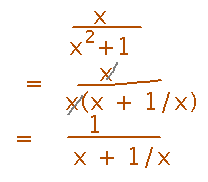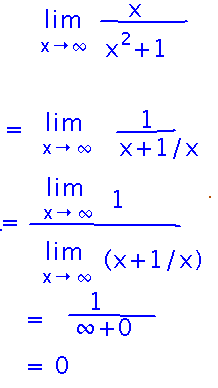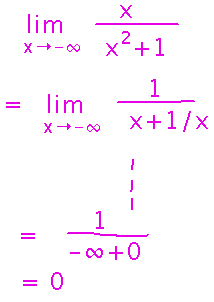Misc
Exam 2 coming up Thursday (April 11).
Covers material since first exam (e.g., implicit differentiation, related rates, initial value problems, linear approximation, extreme values, shapes of graphs — roughly the material on problem sets 5 and 6).
Rules and format otherwise similar to first exam, especially open-references, open-calculator/computer, rules.
Practice exam now on Canvas.
Extended SI session Wednesday April 10, 3:00 - 6:00, Bailey 209
Questions?
End Behavior
Section 4.6.
Example with Graphing
What does y = x / (x2 + 1) look like at its left and right ends?
We decided that the key thing was to find limits as x approaches positive or negative infinity.

Strange as it may seem, factoring x out of the numerator and denominator here is a good way to proceed. It allows us to cancel out the x in the numerator, getting rid of the ∞/∞ problem in the limit, and leaving terms in the denominator that are easy to take limits of at infinity.

Now substitute this rewritten expression into the limit as x approaches positive infinity, and either use limit laws to simplify to terms whose limits we know, using the somewhat intuitive idea that 1/∞ becomes 0, or, more formally, noting that 1/(x + 1/x) can be made arbitrarily close to 0 by making x big enough, which is the formal definition of a limit at infinity.

Similar thinking applies to the limit as x approaches -∞:

So we conclude that the left and right ends of the graph level off at y = 0. Here’s the complete picture as it was when we finished with it in class:

Another Example
What is the limit as x approaches ∞ of y = (x2+1) / x?
Approach this similarly to the first example, namely by factoring x out of the numerator and canceling the denominator. The result is simpler than the first example to find limits of:

Key Points
Avoid ∞/∞
You can often avoid it by factoring the highest common power of x out of numerator and denominator. Then use the following rules, applying limit laws as needed to isolate the necessary forms:
| Function | Limit as x Approaches ∞ | Limit as x Approaches -∞ |
|---|---|---|
| xn, n is positive & even | ∞ | ∞ |
| xn, n is positive & odd | ∞ | -∞ |
| 1/xn, n is positive | 0 | 0 |
| Constant | Constant | Constant |
Next
Optimization: extreme values with constraints.
For example, it’s good to minimize the perimeter of nature preserves, because that perimeter is what pests, poachers, etc. enter through. So what’s the minimum perimeter a rectangular nature preserve of 100 square miles can have?
Read section 4.7.